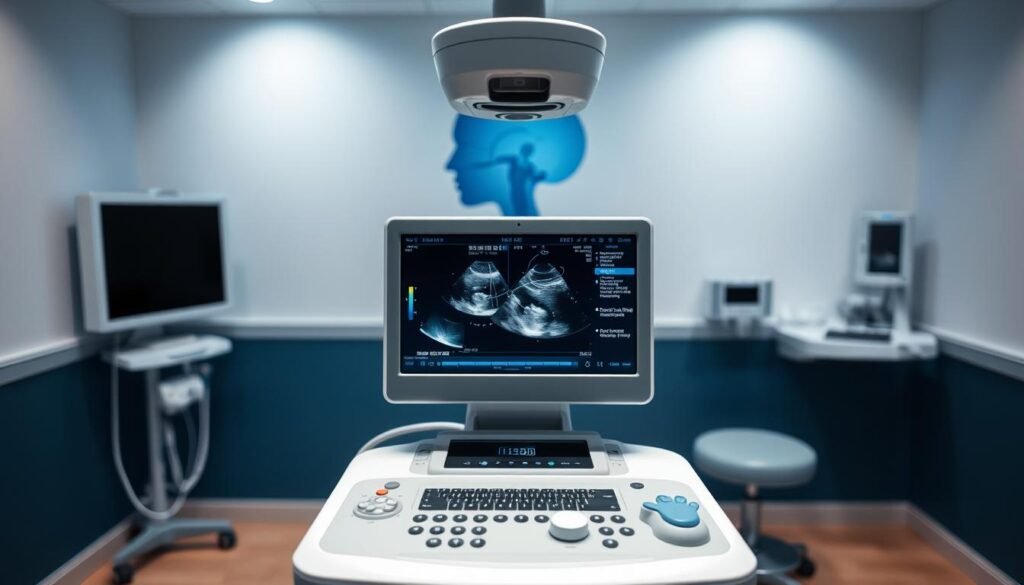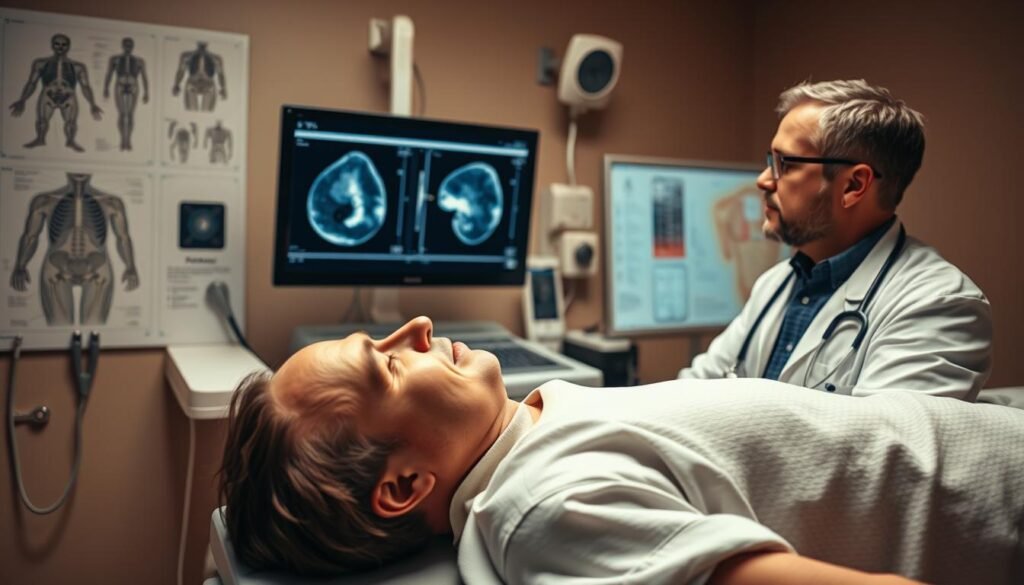Did you know prostate cancer is the top cancer among men in the U.S.? About 299,000 new cases pop up each year. It’s a big concern, affecting one in seven men. Mostly, it hits those over 65.
Many guys don’t know their risk until it’s pretty late. This kind of cancer, called prostatic adenocarcinoma, is a big deal. We wrote this article to help. It talks about risk factors, why early detection is key, and how to treat this cancer.
Key Takeaways
- Prostate cancer is diagnosed in 1 in 7 men, making awareness crucial.
- Age is a key risk factor, particularly for those over 65.
- Black men face a significantly higher risk for aggressive forms of this cancer.
- Genetics and family history greatly influence the likelihood of diagnosis.
- Early detection via screening can dramatically improve treatment outcomes.
- Prostatic adenocarcinoma accounts for 99% of prostate cancer cases.
- Many treatments exist, including surgery, radiation, and hormone therapy.
What is Prostatic Adenocarcinoma?
Prostatic adenocarcinoma is the most common type of prostate cancer. It starts in the prostate gland and can cause health problems. Over 95% of prostate cancers are adenocarcinomas. Knowing about this cancer is vital for effective management.
Definition and Overview
Prostatic adenocarcinoma is a harmful tumor found in the prostate’s gland cells. It often grows slowly, staying unnoticed for a long time. Symptoms might not appear until it’s more advanced. This cancer is more common than other types, like ductal adenocarcinoma or small cell carcinoma.
How Prostatic Adenocarcinoma Develops
Cancer in the prostate starts with genetic changes. These changes make cells grow out of control. Tumors can spread to other body parts. Some cancers grow quickly, posing bigger treatment challenges. Factors like age, lifestyle, and genetics play a role. It shows why it’s crucial to catch it early.
Risk Factors for Prostatic Adenocarcinoma
Getting to know the risk factors for prostatic adenocarcinoma is key. This knowledge can pinpoint who is more at risk. Many factors play into the chance of getting prostate cancer which impacts how we prevent and screen for it.
Age and Incidence
Age greatly affects the chance of getting prostate cancer. Almost 60% of cases are found in men older than 65. This shows that risk goes up with age, especially after 50. Dealing with prostate cancer in older men poses unique challenges.
Race and Ethnicity
Racial differences are clear when looking at prostate cancer risks. African American men are at a higher risk compared to white men. They are also more likely to die from this disease. This fact highlights the need for careful attention and quick action.
Family History and Genetics
Genetics are a big factor in prostate cancer. Having a family member with prostate cancer doubles your own risk. And if two or more relatives are affected, your risk nearly quadruples. Around 58% of cases are thought to be driven by genetics. So, your family’s history with this disease is really important.
Other Potential Risk Factors
Many other things might influence your chance of getting a severe form of prostatic adenocarcinoma. Let’s look at some:
- Eating fewer fruits and veggies and more red meat and processed foods.
- Being obese. This doesn’t raise the overall risk much but is linked to harsher forms of cancer.
- Being exposed to certain chemicals and long-term prostate inflammation.
- Having a vasectomy doesn’t seem to change the risk.
- Ejaculating often might lower the risk of prostate cancer.

| Factor | Impact on Risk |
|---|---|
| Age | Significantly increases risk, especially after 65 |
| Race | Higher risk in African American men |
| Family History | Twice the risk with one relative, four times with two |
| Obesity | Associated with aggressive forms of cancer |
| Diet | High-fat diets can increase risk |
The Importance of Early Detection
Early detection of prostate cancer is key to getting better treatment and improving survival rates. Regular screenings can catch the disease early, making a big difference in health and longevity.
Prostate Cancer Screening Recommendations
Screening should start in the 40s for men, especially if they’re at higher risk. This includes being Black or having a family history of prostate cancer. Screenings usually involve a blood test and a physical exam.
The PSA blood test looks for levels of a specific substance from the prostate. This can show if cancer might be present. Although no test is perfect, the PSA test is good at finding early cancers.
Here are the main screening recommendations:
- Start screening at 50, or 40 if you’re at higher risk.
- Screenings include a PSA test and digital exams for a full check-up.
- Tracking PSA levels over time helps spot any changes that need attention.
- Using advanced tools like multiparametric MRI can make detection better and avoid unnecessary biopsies.
Symptoms to Watch For
Knowing the symptoms of prostate cancer is crucial, even though they might not show up until it’s advanced. Symptoms can include:
- Having trouble urinating
- Finding blood in urine or semen
- Losing weight without trying
With the chance of late symptoms, it’s crucial to screen early. This opens up more treatment options and raises survival chances. Always talk to your doctor about screening for prostate cancer.

Diagnosis of Prostatic Adenocarcinoma
Doctors diagnose prostatic adenocarcinoma in several steps. They start with a digital rectal examination (DRE) and a PSA blood test. These prostate cancer tests help find possible signs of cancer. If they notice anything unusual, they may do more tests like a biopsy, ultrasound, or imaging scans.
Diagnostic Tests and Procedures
The PSA blood test checks for a specific antigen in your blood. A level of 4 ng/mL or more may need further checks. Sometimes, doctors look into it even if it’s 2.5 or 3 ng/mL. If your PSA level is between 4 and 10 ng/mL, there’s a 25% chance you have prostate cancer. Often, this cancer is low-grade and might not need quick treatment. A level over 10 ng/mL means you’re much more likely to have prostate cancer, with over a 50% chance.
A biopsy is the best way to confirm prostate cancer. Doctors usually take 12 samples from various parts of the prostate. The biopsy can show no cancer or confirm its presence.
Understanding Gleason Scores
The Gleason score is key to diagnosing prostate cancer. It grades cancer from 1 to 5 by looking at tumor cells under a microscope. A Gleason score interpretation helps figure out how severe the cancer is and what treatment might be best. Scores of 6 or lower mean the cancer is less aggressive. Higher scores show it’s more aggressive. Knowing this score is very important for patients and doctors to plan treatment.

For more on how prostate cancer is diagnosed, check this resource. It has a lot of information on checking for prostate cancer.
Treatment Options for Prostatic Adenocarcinoma
Treatment options for prostate cancer depend on the cancer stage, patient health, and personal choices. Each method has its own ups and downs.
Surgical Interventions
Surgery is often used for cancer that hasn’t spread. The main surgery, radical prostatectomy, removes the prostate and surrounding tissues. This surgery lowers the chance of cancer coming back, especially in men with good initial tests.
Radiation Therapy
Radiation therapy comes in two types: external beam and internal (brachytherapy). The choice depends on the cancer’s stage. For higher-risk cancers, radiation might be used alone or with hormone therapy to work better.
Chemotherapy and Androgen Deprivation Therapy
In advanced prostate cancer, chemotherapy is an option. It’s often paired with androgen deprivation therapy (ADT). ADT lowers testosterone, helping to control or shrink the cancer. This combo is key for treating high-risk cancers.
Active Surveillance Approach
Active surveillance works for very low or low-risk cancers. It involves monitoring the cancer without treating it right away. Regular health checks catch any changes quickly. This approach is good for slow-growing cancers, avoiding the side effects of other treatments.
| Treatment Option | Best For | Potential Risks |
|---|---|---|
| Surgery | Localized cancers | Infection, incontinence, erectile dysfunction |
| Radiation Therapy | Intermediate to advanced stages | Fatigue, urinary issues, bowel problems |
| Chemotherapy | Advanced cases | Nausea, hair loss, increased infection risk |
| Active Surveillance | Very low-risk cancers | Potential for cancer progression |
Managing Side Effects of Treatment
Men going through prostate cancer treatment often deal with both physical and mental challenges. It’s important to tackle the side effects to improve well-being and life quality. Fatigue, lower sexual desire, issues with peeing, and stomach problems are common. Yet, there are ways to handle these effects effectively.
Common Side Effects
Patients might face different side effects that affect their day-to-day life. The top issues reported include:
- Fatigue: Feeling very tired is a typical reaction to cancer treatments, making it hard to do normal activities.
- Erectile Dysfunction: Damage to nerves or hormonal shifts can make getting erections tough. Drugs, vacuum devices, and surgical options can help with this problem.
- Urinary Incontinence: Problems can show up as the need to pee a lot, suddenly needing to go, and leaking.
- Gastrointestinal Symptoms: Treatment might cause changes in bowel movements and discomfort.
Helpful advice is available through different resources for managing treatment effects.
Support and Resources for Patients
Getting to the right support resources is key after prostate cancer treatment. Support groups offer emotional help, letting patients and families share experiences and tips. Educational materials teach about managing side effects, understanding treatments, and the path to recovery.
Talking to doctors like urologists and physical therapists helps too. They can suggest exercises for better pee control and faster healing. Also, there are programs to help pay for continence aids.
In short, finding support groups and using educational tools makes recovering from prostate cancer treatment smoother.
Lifestyle Changes to Reduce Risks
Making important changes to your lifestyle can be key in lowering prostatic adenocarcinoma risks. These changes include following dietary advice and exercising regularly. By adopting these healthy habits, people can improve their general health. This may also reduce the chance of developing prostate problems.
Dietary Recommendations
A balanced diet for prostate cancer prevention includes many foods that are good for prostate health. Important dietary tips are:
- Eating lots of fruits and veggies, especially those high in antioxidants like tomatoes and greens.
- Adding whole grains and eating less red meat and processed foods.
- Taking advantage of lycopene in cooked tomatoes, which might slow prostate cancer cell growth.
- Considering adding soy products and green tea to your diet, as they could lower PSA levels.
- Keeping a healthy weight, since being overweight is linked to a higher risk of aggressive prostate cancer.
Exercise and Physical Activity
Exercise and prostate cancer are linked, with physical activity offering big benefits. Experts suggest 150 to 300 minutes of moderate exercise each week. Regular exercise helps keep your weight in check. It also leads to better outcomes during treatment. Benefits of exercising include:
- Lowering the chance of prostate cancer coming back and fighting more aggressive types.
- Boosting mental health and enhancing life quality.
- Helping with hormone balance, which is important for prostate health.
Current Research and Future Directions
Researchers are diving deep into prostate cancer’s complexity. They are looking for genetic clues and prevention tactics. This includes diet and medication changes.
New diagnostic tools are being developed. Advanced imaging is making early detection easier and more accurate.
Advancements in Treatment Options
The latest treatments for prostate cancer are showing great promise. Focus is on targeted therapies and hormone treatments. These methods are refining the management of the disease.
Studies reveal that combining hormone therapies with radiation can extend lives. This suggests a move towards more effective treatments.
Emerging treatments aim to stop tumor growth by interfering with cell adhesion. This innovative approach could make a big difference.
The Role of Clinical Trials
Clinical trials are key for advancing prostate cancer treatment. They test new treatments and therapies. This research is crucial for developing future treatment options.
Patients should talk to their doctors about joining clinical trials. This can give them access to new treatments. For more info, check out this comprehensive resource.
Conclusion
Understanding prostate cancer is key to good health care. Prostate cancer represents a quarter of all cancers in men worldwide. Knowing about this can help catch it early and start treatment sooner.
Screenings help spot symptoms and risks quickly. This allows for better decisions about how to treat it.
New treatments like robot-assisted surgeries are changing how we fight prostate cancer. But, learning about early signs is still very important. For more info, look at current studies on prostate cancer. They offer insights on survival rates and how different hospitals perform.
It’s also important to know the symptoms early on. This includes problems peeing or bone pain that comes out of nowhere. Being aware helps people seek help faster.
This knowledge supports patients and their families. It helps them be ready to deal with prostate cancer. For tips on spotting symptoms, check out symptom awareness platforms.